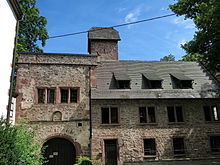Gemmingen-Steinegg
Gemmingen-Steinegg is a line of the family of the barons of Gemmingen .
history
Beginnings
The line comes from Diether V. von Gemmingen († before 1428), who comes from the fifth generation after the oldest known Gemmingen progenitor Hans and was married to Anna von Selbach. He acquired property in several places on the northeastern edge of the Black Forest. His son Diether VI. was involved in several feuds as a militant Baden country steward and was able to round off the property that had been acquired by his father and which had fallen to him with the partition contract of 1425 with numerous goods deals.
The resulting territory (called Biet or area ) consisted of the eight districts Hamberg , Hohenwart , Lehningen , Mühlhausen an der Würm , Neuhausen , Schellbronn , Steinegg and Tiefenbronn . It was under the feudal sovereignty of the Margraviate of Baden-Durlach ; the military and tax sovereignty lay with the Swabian knightly canton Neckar-Black Forest .
Despite the suzerainty of Baden-Durlach, which had become evangelical, the eight towns in Biet were not reformed in the 16th century. Members of the family line had held the highest ecclesiastical offices, so that the line, in contrast to the other Gemmingen lines, remained Catholic for the time being. So the bid became a Catholic island in the Lutheran area.
The line Gemmingen-Steinegg (also Gemmingen-Hagenschieß ) was through the grandchildren Diether VI. has been divided into two branches:
Branch Steinegg
Based on Dietrich VIII. († 1542) ∞ Katharina von Neuhausen (1481–1563) and her descendants. Son Dietrich IX. (1517–1586) was councilor and governor of Dillingen. His sons Georg and Hans († 1591) were commander of the Teutonic Order. Her brother Johann Konrad von Gemmingen (1561–1612) was Prince-Bishop of Eichstätt. The brother Wolf Dietrich (1550-1601) continued the line. He was in command of the Upper Baden occupation and later court master of his brother, Prince-Bishop Johann Konrad. The line continued with the descendants of his son Karl Dietrich (1583–1629). Whose great-great-grandson Johann Dietrich (1716–1778) was court marshal to the princes of Taxis , the bishops of Speyer and the margraves of Baden-Durlach and knight captain in the knightly canton of Neckar-Black Forest . His son Franz (1746–1797) had only one son who died young, so that with him the branch died out in 1797 in the male line. Two of his daughters married brothers from the Mühlhausen branch.
Branch Mühlhausen

Based on the prince-bishop-Würzburg court master and chief bailiff in Eltingen Otto (1475–1558) ∞ Maria Güß von Güssenberg († 1572) and her descendants. Otto's son Hans Dietrich (1516–1566) briefly owned Weinfelden in Thurgau . His son Hans Christoph (1544–1596) acquired Liebenfels Castle in Thurgau, which remained in the family's possession until 1654. Otto's son Johann Otto von Gemmingen was Prince Bishop of Augsburg (1545–1598).
Under the descendants of his brother Hans Diepold (1554–1612), the family split into several branches after a few generations. Wolf Dietrich von Gemmingen (1680–1738) was the prince-bishop's secret councilor and caretaker at Abensperg. His son Wolfgang Reinhard Joseph (1710–1760) founded an Austrian branch that was extinguished in 1849. Wolf Dietrich's daughter Maria Anna Margaretha von Gemmingen became abbess of the Lindau canonical monastery. Wolf Dietrich's brother Reinhard Ludwig (1681–1726) is the progenitor of the still existing sub-branches Gernsbach and Unterbessenbach. His grandson Julius von Gemmingen-Steinegg (1774–1842) combined ownership of the entire family line in 1805 for the last time.
After 1805/1806
However, shortly after reunification in 1805, the existence of the Gemming small state ended - it was incorporated into the Grand Duchy of Baden in 1806. Julius converted to the Protestant faith in 1823. His son Eduard (1807-1884) was the only member of the family to remain Catholic and in 1836 took over the property together with his brothers Joseph and Gustav. At the time of the replacement of the noble rights, the brothers sold almost the entire family line and acquired property in other places: Eduard in Maisenhausen and Damm (near Aschaffenburg), Joseph (1804–1873) in Gernsbach and Gustav (1808–1895) in Unterbessenbach .
Joseph's son Julius (1838–1912) in Gernsbach was a supporter of Protestant community life, and his daughter St. Clair (1863–1951) arranged for the castle to be rebuilt as a denominational youth meeting place. In addition to the Unterbessenbach Castle , the Unterzweig in Bessenbach also acquired the Villigst House , which is now rented to a Protestant institution, and the Cotten farm .
The former Gemming'sche area southeast of Pforzheim is still called area or Biet (probably from Gemming'sches dominion area ). This is the name of a local municipal water supply association for regional communities ; it is based in Tiefenbronn.
Important members of the family line


- Johann Otto von Gemmingen (1545–1598), Prince-Bishop of Augsburg
- Otto von Gemmingen (1475–1558), court master of the Prince-Bishop of Würzburg and chief bailiff in Eltingen
- Johann Konrad von Gemmingen (1561–1612), Prince-Bishop of Eichstätt
- Wolf Dietrich von Gemmingen (1680–1738), prince-bishop councilor of Eichstätt
- Maria Anna Margaretha von Gemmingen (1711–1771), abbess of the Lindau Canon Church
- Julius von Gemmingen-Steinegg (1774–1842), lord of the castle and landlord on Steinegg, member of the Baden Estates Assembly
- Julius von Gemmingen-Steinegg (1838–1912), lieutenant in the Grand Duke of Baden
- Julius Heinrich von Gemmingen-Steinegg (1843–1903), Prussian infantry general, first president of the military court in Berlin
- St. Clair von Gemmingen-Steinegg (1863–1951), lady of the castle on Steinegg
See also
literature
- Carl Wilhelm Friedrich Ludwig Stocker : Family chronicle of the barons of Gemmingen , Heidelberg 1895.
- Heinrich Leicht: Neuhausen under Gemmingsch rule , in: Community Neuhausen (Hrsg.): Neuhausen once and now. Volume I , Horb 2001, pp. 52-62.
- Alois Amann: Emigration from the Gemming rule of Steinegg to Hungary 1740–1840 , Pforzheim 1984.

